Sharlyn J. Lauby's Blog, page 127
November 12, 2017
Reporting Workplace Bullying to HR – Ask #HR Bartender
A few days ago, I read a post on the Society for Human Resource Management (SHRM) blog titled, “Why Should I Bother to Go to HR About Sexual Harassment?” It’s a good read and you might want to check it out. It’s also kinda related to today’s reader note. They’re trying to figure out if HR is a place they should go with their issue.
I was suspended 4 months ago after having worked for the company for over 20 years.
Last year, I took out a grievance because I was being bullied. The grievance wasn’t upheld, but on appeal parts of it were. Afterward, I had to work with one of the people who bullied me. Then, I was suspended for allegedly falsifying a document (which I did not do).
I have not been to a disciplinary hearing, and I recently found out that my job has been advertised. My union has advised me to write a letter to human resources because I am unlikely to get a fair hearing. I have evidence that the allegation was brought by close friends of the bully along with inconsistences in their statements.
Is writing a letter to HR the right thing to do?
Honestly, from the reader’s note, I feel like there are multiple sides to this story. And I’m sure that we don’t know enough to answer all the specifics in this situation. But the note touches on bullying, investigations, and retaliation. I think it would be good to discuss those matters because, unfortunately, these issues are prevalent in today’s workplaces.
To help us, I asked our friend Kate Bischoff to share her knowledge. Kate is an employment attorney and HR consultant at tHRive Law & Consulting LLC. She’s shared her experience with us before – one of my favorite articles is this one about “HR Failed to Investigate an Incident”.
Now, I know you realize this, but please remember that Kate’s comments should not be construed as legal advice or pertaining to any specific factual situations. If you have specific detailed questions, they should be addressed directly with your friendly neighborhood labor attorney. And thank you!
Kate, let’s start with the topic of workplace bullying. Why should organizations be concerned about workplace bullying?
[Bischoff] Bullying is destructive. Period. When employees are bullied, they are working in fear and intimidation, which reduces overall work quality, innovation and employee engagement. While it may not pose a litigation risk from a legal standpoint, bullying leaves no room for trust and trust is essential for a positive workplace.
After seeing the reader’s note, I can imagine someone saying to themselves, “If I’m being bullied, the last thing I should do is file a grievance.” Is there a proper way for employees to let the company know they’re being bullied?
 [Bischoff] There is no proper way per se. Most employers should have a mechanism for their employees to report bad behavior, like bullying, harassment, or other suspicious behavior. This could be an ethics hotline, pulse-like engagement feedback on a daily or weekly-basis, or simply having HR walk around to build relationships with employees so employees feel comfortable talking with us. Employees should feel comfortable using these mechanisms.
[Bischoff] There is no proper way per se. Most employers should have a mechanism for their employees to report bad behavior, like bullying, harassment, or other suspicious behavior. This could be an ethics hotline, pulse-like engagement feedback on a daily or weekly-basis, or simply having HR walk around to build relationships with employees so employees feel comfortable talking with us. Employees should feel comfortable using these mechanisms.
Even if there is a ‘formal’ way to report this behavior, employees should also feel free to report it to ANY manager. Managers are the company for all intents and purposes, so telling a manager should trigger action by the company, provided that managers know what to do. And, there’s the rub. Managers who don’t know what to do – especially in a bullying or harassment situation – can cause the company even more harm by their inaction.
If an employee feels they are being retaliated against because they spoke up, is there something they can do?
[Bischoff] Kinda sorta. Employees who believe they are being retaliated against should notify the highest person in HR (VP, Director, CFO even) or go to the general counsel of the business and explain that they believe they are being retaliated against.
The newly informed individual has probably been outside the decisions viewed as retaliation and will want to investigate to determine if retaliation is occurring. If this person has been notified of the actions, they probably believe it is not retaliation and will not take steps to remedy it. But employees should try. Please try. Even if you tell them after you find another job, please tell someone.
If you are retaliated by losing your job, being demoted, or suffered some other adverse employment action, you should talk with your state’s civil or human rights agency or contact the Equal Employment Opportunity Commission (EEOC). While most of us management-side attorneys will hope you talk to someone in your company first, those agencies are always an option.
What should HR departments do to make sure that employees know the company will not tolerate retaliation?
[Bischoff] Listen, we in HR have a reputation of not helping employees when they complain. This reader letter embodies this reputation. Whether the reputation is deserved or not can be debated, but we’re stuck with it – for now. So, we need to fight the reputation.
Know your co-workers. Listen to them. Investigate. Protect employees after they complain. Don’t go along with a manager who is behaving in a retaliatory manner. Work to find workable solutions to prevent and prohibit bullying even if that means pushing bullies out of the workplace for good. If we all do this, our reputation will improve and employees will not be too scared to come to us. That said, HR has lots of other ways we can make sure retaliation isn’t tolerated.
We must talk with managers about retaliation itself and the perception of retaliation.
We should have policies in handbooks that explain that retaliation will not be tolerated.
We also should check in with employees who have complained to make sure they don’t feel tolerated.
We shouldn’t hang back until they come to us, we should go to them.
Last question, if an employee who is accused of misconduct has evidence that is relevant to the investigation, should they submit it in writing?
[Bischoff] ABSOLUTELY! I’m a lawyer. I hate trees. Paper is where it is at. It doesn’t have to be in hard-copy format, it can be emailed with the handy-dandy date and time stamp right on the email. (Contrary to last year’s news articles, it is really hard to destroy an email.) If you need to complain about behavior or give additional evidence outside of a formal investigative interview, then submitting something in writing is the way to go.
My thanks to Kate for sharing her experience and knowledge with us. And her ability to deal with a very serious subject in a casual way. I hope everyone appreciated the subtle hint of self-deprecating humor with the tree comment (smile). If you want to read more of Kate’s insights, be sure to check out her blog. It’s a must read.
Retaliation claims are more than a legal risk. Yes, it’s true – retaliation can cost companies thousands of dollars. But they can also ruin company culture. And when your culture is of distrust, well…you know…
Image captured by Sharlyn Lauby after giving a presentation at KronosWorks 2016 in Orlando, FL
The post Reporting Workplace Bullying to HR – Ask #HR Bartender appeared first on hr bartender.






November 10, 2017
Office Space Is an Employee Engagement Issue [infographic] – Friday Distraction
I know a lot of people toss everything into the “employee disengagement” pile. This causes disengagement. Or that causes disengagement. Reality is, the drivers of employee engagement (or disengagement) are the things that drive work and productivity. A foosball table, while it’s fun and cool, probably doesn’t drive work. Therefore, it’s not a driver of employee engagement.
On the other hand, your office space does impact your productivity and the quality of your work. So, office space could be an engagement driver. Today’s infographic from Cubicle Concepts talks about some things that companies should think out when creating office space.
I particularly liked the focus of this infographic on ergonomics and wellness.
Lighting, color, and plants can have a positive impact. As someone who once had their office located in the basement, let me tell you that windows can make a huge difference on your outlook. Same with color. Have you ever worked for a company where the employee hallways were brown or beige? A little pop of color can have a huge effect on employee engagement!
Posture, desk space, and sounds can detract. I’ve spoken before about the importance of good posture. Having a great chair is essential. Equally important is having a proper desk at the right height. I’m also hearing about a growing number of companies issuing headphones to employees so they can tune out noise. Give employees the work space they need to do their best work.
I know some companies are questioning the open office space concept and for good reason. I believe organizations have to decide what works best for them. Whether you have open space or not, employees still need a proper workspace. Organizations are probably not getting their best work from employees when they’re being asked to work in cramped, noisy, ugly work spaces.
The post Office Space Is an Employee Engagement Issue [infographic] – Friday Distraction appeared first on hr bartender.






November 9, 2017
Before Interviewing, Train Hiring Managers on These 5 Things
Managers have a tough job and a full plate. They’re responsible for their department planning, organizing, leading, and controlling. They’re also responsible for hiring. But managers themselves are often hired and promoted for their technical expertise, not their ability to hire others.
This means that organizations need to give hiring managers all the tools they need to hire effectively. And it’s more than just interview skills training. Personally, I believe interviewing is hard and complicated. It’s more than simply asking questions. Companies can do their managers a real disservice when they dismiss interview skills training as unnecessary.
In addition to interview skills training, here’s a list of things that managers should know when they are responsible for hiring. These topics could be shared during one-on-one sessions or added to the company’s interviewing skills training program.
1. The cost and impact of hiring decisions. Hiring an employee isn’t cheap. And a bad hire has an impact on everyone in the company. Managers should understand what it costs. I once worked for a company that, before we even started talking about interviews, etc., we had managers calculate cost per hire (CPH). Then had a discussion about what CPH could buy (i.e. equipment, pay increases, bonuses, etc.) It set the stage for the rest of our training time.
2. Their role in the hiring process. Often managers are asked to interview without understanding the entire recruiting process – branding, sourcing, candidate experience, selection, screening, etc. There’s so much more to the process than the interview. Hiring managers would be better interviewers if they knew what happens before and after.
3. Reviewing the job description. Let’s face it. Organizations have two job descriptions: the one that’s written down for legal purposes and the one we talk about to get someone excited about coming to work for the company. Hiring managers need to make sure the job they communicate to candidates aligns with the copy of the job description that HR provides to candidates. HR and legal departments might want to collaborate on this one.
4. Understanding the law. Speaking of the law, hiring managers need to know what’s legal to discuss and how to take good notes. Even if the company has an excellent recruiting technology solution, it’s possible there will be times when taking handwritten notes might be necessary. Legal information might vary by state or country. It could also vary by industry. Oh, and one more thing…hiring managers should know how to extend a proper job offer. They might not do it every day, but they should know how (just in case).
5. How to evaluate a candidate. Personally, I find that the selection part of the hiring process frequently gets shorted. We spend so much time sourcing and interviewing, only to spend 10-20 minutes on selection. If that’s all the time needed, then great. But I do wonder if it should be longer. Hiring managers should receive some kind of self-awareness and bias training. They need to know how to objectively evaluate the skills and qualifications of a candidate.
One of the biggest responsibilities that managers have is hiring. Because if they don’t do it well, then the other functions of their job (planning, organizing, leading, and controlling) will not go well. Organizations need to give managers the skills they need not only to interview, but understand the recruiting process. That translates into better hires who can help the company achieve its goals.
P.S. I’m very excited to be speaking about manager onboarding at this year’s Recruiting Trends & Talent Tech conference being held on Tuesday, November 28 at the Palm Beach County Convention Center. With recruiting being both a challenge and a top priority for companies, this is one show you do not want to miss. HR Bartender readers get a $100 discount on premium passes to the event.
The post Before Interviewing, Train Hiring Managers on These 5 Things appeared first on hr bartender.






November 7, 2017
4 Digital Trends That Are Transforming Today’s Workplace
(Editor’s Note: Today’s post is sponsored by TalentMap , a firm specializing in employee engagement solutions. They help organizations measure and improve employee engagement through action-centric employee survey programs. Enjoy the post!)
I don’t believe it’s a surprise to anyone that technology has changed the way we do business. Regardless of the industry you’re in, technology has impacted who does the work, the methods we use to work, and how fast we work. Think about the fact that ten years ago, these products didn’t exist: iPad, Google Chrome, Kickstarter, Android, Lyft, Square…just to name a few. And now, some of these aren’t just nice to haves but essential tools for us to get work done.
But if technology is going to continue to move this fast (and there’s no reason to think it won’t) then business leaders and HR pros have to stay on top of digital trends to attract, engage, and retain the best talent. Organizations cannot afford to fall behind when it comes to technology.
4 Digital Trends that Can Impact Your Organization
While organizations do not have to adopt every single technology trend, they do need to be aware of trends and evaluate their potential impact. For instance, here are four digital trends that organizations should be looking at. For each, I’ve included how each of the digital trends impacts the workplace, along with a way to use the trend to help build better employee engagement.
TREND #1: Artificial intelligence (AI) is changing the way work is designed. We’ve been talking for well over a decade about the rise in the knowledge economy. It’s time to take it one step further and think about the digital economy. Knowledge workers need to become digital workers.
In order for this transformation to take place, organizations – and specifically, human resources professionals – have to design work with technology in mind. I know it’s tempting to start freaking out about the articles saying AI is going to take away your job. But before companies start doing that, it could make some sense to discover how AI can reduce boring work for employees, making their jobs more attractive. Good job design allows companies to attract the best talent and retain them.
TREND #2: User experience (UX) is giving way to the candidate and employee experience. I ran across a quote in a Forbes article that really justifies the investment into user experience. It’s from Robert Pressman’s book “Software Engineering: A Practitioners Approach”. “For every dollar spent to resolve a problem during product design, $10 would be spent on the same problem during development, and multiply to $100 or more if the problem had to be solved after the product’s release”. What this means is, for every dollar invested in UX, the return is between $10 – $100, indicating that the most cost-effective way to address a problem is from the start.
Now, use the same philosophy on the workplace. Nearly 60 percent of candidates have a poor candidate experience. Seventy-two percent (72%) of them choose to share that fact online or with someone directly. Organizations need to make investments in the employee experience beyond a competitive compensation and benefits program. To get a high return on your recruiting and hiring investment, survey employees regularly for feedback about what they like and want to see changed.
TREND #3: Technology is paving the way for agility and innovation. A great example of how technology is ushering in change and innovation is the Internet of Things (IoT). It’s a computing concept where everyday objects are connected to the internet and can identify themselves to other devices. Examples that you might be using right now include fitness trackers and smart thermostats. The IoT industry is expected to grow to over 50 billion connected pieces of technology by the year 2020. This means organizations have to think beyond their internal sources for intelligence and knowledge management. It’s simply impossible to have all of your intellectual bandwidth in house.
One way that organizations can embrace the IoT trend is by preparing for the emergence of “app culture”. Individuals are accustomed to using apps in their personal lives for everything from adjusting the lights inside their home to banking to keeping their passwords secure. It’s not farfetched for employees to expect the same. If you want to attract and engage employees, think about where and how they spend their time.
TREND #4: Digital capabilities are creating greater opportunities for telework and contingent work. According to the Society for Human Resource Management’s research report “The New Talent Landscape: Recruiting Difficulty and Skills Shortages”, 68 percent of HR pros are experiencing recruiting challenges. It only makes sense for organizations to invest in areas where current employees can stay engaged and retained with the organization.
Two areas where surveying employees could bring huge results are freelancing and telework. Granted these might not be for everyone, but the benefits could outweigh any perceived costs. For example, 57.3M people freelance and they contribute $1.4T to the U.S. economy. Using a contingent workforce and help reduce stress during busy operational times. It’s also possible that former employees might be willing to take a few gigs on the side. And when it comes to telework, 64 percent of employees would opt for a lower paying job if they could work away from the office. While reducing employee pay isn’t the goal, it’s important to note the popularity of the telework.
Digital Transformation Involves a Culture Adjustment
All of these digital trends point to more than just adding a couple of employee programs. They involve redesigning work and the workplace. Digital transformation needs to be considered as part of company culture. That’s how organizations will attract, engage, and retain the best talent.
P.S. If you want to learn more about how to bring digital transformation into your organizational structure, join me and TalentMap Founder Sean Fitzpatrick on Thursday, November 16 at 1p Eastern for a conversation about “Digital Transformation and the Future of Employee Engagement”. And if you can’t make it, sign up anyway so you can get the recording sent afterward. It’s sure to be an intriguing conversation.
P.S.S. Oh! And one more thing, TalentMap has a special offer for HR Bartender readers. If you would like a copy of their book “Employee Engagement and Action Planning”, just use promo code HRB2017. It’s a hard copy book (not a download) and filled with practical advice on implementing an engagement strategy. I particularly liked the section in Chapter 4 where it talks about dealing with senior managers who haven’t embraced the plan. Definitely worth checking out.
The post 4 Digital Trends That Are Transforming Today’s Workplace appeared first on hr bartender.






November 5, 2017
Create a Personal User Manual So Others Know How to Work With You
I ran across a tweet recently that posed an interesting thought: What if managers created “personal user manuals” about their management style? Back in the old days, we called this managing up. Managers would share information about themselves with their teams – things like “I’m not a morning person.” or “I like communicating via email.”
Employees could then use the information about the best times and methods to communicate with their manager to help them get the necessary resources to do their job. Thinking back, managers were, in a way, giving employees a personal user manual.
But, in thinking about the personal user manual concept, it seems like limiting this to managers could be short-sighted. Why not ask every employee to create a personal user manual? I can see two huge benefits:
Employees learn more about each other. The original idea of a personal user manual is to help others learn more about you. Great communication starts with understanding your audience. Personal user manuals are basically the audience giving you the roadmap to working with them.
Employees learn more about themselves. Writing a personal user manual for others implies a tremendous amount of self-awareness. You can’t tell others the best way to work with you…if you haven’t figured it out for yourself. Today’s business world requires employees to self-manage. This activity could be a good first step.
Creating a personal user manual can be something you do on your own. I could see it being a part of career journaling. Or it could be an activity that takes place during onboarding. The organization could give new hires a Moleskine (or something similar) and ask them to journal their first 30 days on the job.
How can you turn your career journal into a personal user manual? Here are five steps to get you started:
Think about how you would use this information. And who you would share it with. Developing a personal user manual has a goal – better communication. Consider what information you would like to share and the co-workers you want to share it with.
Be prepared to accept the personal user manuals of others. Before doing anything realize that, unless you plan to keep the manual completely to yourself, you need to be open to accepting the manuals of others. This means being open to changing your style so you can communicate with them better.
Conduct a self-assessment. Start documenting how you like to communicate, make decisions, collaborate, problem solve, etc. If you’re stuck, pull out personality assessments you’ve taken and old performance reviews. They might offer you a baseline to get started.
Solicit feedback. After you document your thoughts, consider getting some feedback about your manual. Each of us has perceptions about ourselves that may or may not align with what others think. And the activity of creating a personal user manual is going to bring those to light.
Regularly revisit your manual. Times change and we do too. As new communication methods emerge, you could discover new ways that you really enjoy (or that totally aggravate you). Not only should you review the information in your manual, but revisit the goals and make sure the manual is accomplishing what you want.
Personal user manuals could be an individual or team activity to improve performance through better communication. It does involve commitment to completing the activity. But the rewards of transparency, feedback, and openness could be worth the time and effort.
Image capture by Sharlyn Lauby after attending the Great Place to Work Conference in Austin, TX
The post Create a Personal User Manual So Others Know How to Work With You appeared first on hr bartender.






November 3, 2017
Bookmark This! Resources for Companies to Develop Innovation
I ran across an old Fast Company article titled “Why Innovation Matters”. While it was written years ago, the concepts still apply. There was one sentence that really stuck out for me.
“To succeed, companies need to see innovation not as something special that only special people can do, but as something that can become routine and methodical, taking advantage of the capabilities of ordinary people, especially those deemed by Peter Drucker as knowledge workers.”
It made me wonder how many organizations take the time and dedicate the resources for innovation to become a process. When we look at other organizational processes, there are things that we can focus on, which could improve innovation.
Employee Engagement is the Key to Innovation
Looking for the next breakthrough innovation? Look at your levels of employee engagement. Low engagement can stifle innovation and impede implementation.
Smart Innovation Takes Competent Leadership
We know the value of innovation in business success. When there is a need to do something different, smart leadership skills get the best results.
How Companies Support Innovation
Companies like Kronos, KPMG, and Quicken Loans are developing innovative cultures. They know the value human resources brings to innovative culture growth.
10 Skills Necessary to Innovate
Innovation skills can be taught. But what skills do employees need to innovate? Here are the 10 skills necessary to innovate successfully.
Your Company’s Next Innovation Will be the Result of Empathy
Empathy drives employee behaviors – those behaviors companies need for innovation. Technology is great but it doesn’t replace dealing with people.
One last resource I wanted to share was the book “The Innovation Revolution: Discover the Genius Hiding in Plain Sight” by K. Melissa Kennedy. I think it aligns with the idea that innovation can be cultivated within organizations.
The book offers a three-part plan for individuals looking to better their innovation skills. I’m not going to give away the entire plan, but let me say that it does focus on systemic thinking and change management. Melissa also gives readers access to several digital tools including an assessment and workbook. I like that the book has so many practical tools that can be immediately used at work.
Organizations want innovation. The good news is they don’t have to sit around hoping and wishing it would happen. Innovation can be developed to become a part of company culture.
Image captured by Sharlyn Lauby somewhere off the coast of Miami Beach, FL
The post Bookmark This! Resources for Companies to Develop Innovation appeared first on hr bartender.






November 2, 2017
The Culture Series [Part 3] – Using Leadership to Establish Cultural Identity
In the previous article of this series on cultural identity, we talked about the first two competencies organizations should focus on developing: 1) trust and 2) emotional intelligence. If employees are not self-aware and cannot build trusting work relationships, it will be very difficult to develop the other two competencies: leadership and agility.
Competency #3 –Leadership in Cultural Identity
Leadership is the ability to influence others. It exists in every person at every level in an organization. The first step in becoming a leader is to learn about ourselves. Organizations have tools such as personality assessments, multi-rater feedback, mentoring, and coaching to help individuals understand their own motivations and behaviors.
Another way to grow as a leader is by gaining knowledge of your social identity. This relates to our inclusion within certain social groups such as age, gender, race, religion, nationality, socioeconomic status, sexual orientation, etc. The concept was pioneered by Henry Tajfel, a social psychologist, in the early 1970’s.
Social identity establishes three things:
It tells us about ourselves viz a vie the groups we identify ourselves with
It enhances self-esteem by feeling emotionally connected with a group
It provides an opportunity to understand people or groups who are different from ourselves
Effective leaders can work with differences. Tracey Burton, former director of diversity at Target Corporation, says working with differences is the key to breakthrough results. “I think the greatest benefit we have found is that diversity drives innovation. People from different backgrounds engaged in thoughtful debate leading to groundbreaking solutions. When you have a team that is engaged and reflective of your consumer base, you can better understand, anticipate and meet the needs of your guests.” Leadership creates the internal awareness necessary to start thoughtful, effective dialogue.
Competency #4 – Agility and Change in Cultural Identity
Every person and organization experiences change. Some changes are big, others are small. Changes can be voluntary (as in, “I’d like to learn how to speak Spanish.”) or forced upon us (i.e. “We need to do business differently.”). Today’s business professional must be able to quickly recognize the need for change and successfully navigate the change process.
Denice Kronau, former chief diversity officer for Siemens, says recognizing our own personal biases is crucial to effective change management. “When I’m hiring someone, I’ll hire a little Denice, because it’s easier – that’s our natural tendency as people. But research also shows that over time diverse teams out perform non-diverse teams. So, with that, once I understand that I have a bias to go hire a little Denice, I know to compensate for that bias in my hiring decisions and my work decisions.”
It’s up to individuals to recognize their possible biases and take actions that will balance those for the benefit of everyone, including the company. The process might take an individual outside of their comfort zone creating a fear or apprehension that’s difficult. It’s equally important for individuals to find a support system to discuss change and their feelings as a way to manage the process. At this year’s Great Place to Work Conference, PwC U.S. Chairman Tim Ryan talked about the company’s acknowledgement and willingness to start discussing uncomfortable issues.
The same applies to a team environment. Groups might be faced with changing their normal behaviors. The group dynamic can be impacted as individuals are processing change at various levels and at different paces. Ultimately, the group needs to feel confident that the outcome will be best for the team and supportive of the individuals as they work through the change process. Adapting to change quickly and positively keeps inclusion at the forefront.
Organizations continue to face the pressure of keeping up with the speed of change. The only way to do it successfully is to build company cultures that are inclusive. That means investing in leadership at every level and giving individuals the support and freedom to be themselves.
Image captured by Sharlyn Lauby at the 34th Street Graffiti Wall in Gainesville, FL
The post The Culture Series [Part 3] – Using Leadership to Establish Cultural Identity appeared first on hr bartender.






October 31, 2017
How to Evaluate the Success of Your Company’s Onboarding Program
(Editor’s Note: Today’s post is brought to you by our friends at SilkRoad , a global leader in Talent Activation. At this year’s HR Technology Conference and Expo, SilkRoad announced a strategic partnership with CareerBuilder to provide client companies an enhanced onboarding experience . Enjoy the post!)
At some point, all company programs have to be evaluated. The reason is obvious. Organizations don’t want to spend their time and resources doing something that brings no value. The question becomes, what’s the best way to evaluate success. Here are the two key areas to cover during an evaluation:
1. What is the organization spending?
2. What level of value is the company receiving?
It’s the classic return-on-investment (ROI) calculation. Obviously, the value needs to match (or preferably outweigh) the cost. Even if you don’t want to calculate ROI, that’s fine. Still have a conversation during program development about evaluation. Ask the question “What does success look like?” The group can agree on things like less turnover, more employee engagement, and increased productivity. Then, the group can figure out how they want to track those results.
Quantitative Methods for Measuring Onboarding Results
I believe that the majority of the time, when we talk about program evaluation, we’re talking about numbers. But even when numbers are involved, there are different methods that can be used. Here are three examples:
Kirkpatrick Levels of Evaluation: Created by Donald Kirkpatrick, this model has become the standard for measuring training program effectiveness. It consists of four levels – reaction, learning, behavior, and results. The interesting aspect of the model is, it suggests that there’s an inverse relationship between the ease in gathering the evaluation data and the value of the data.
Let’s use orientation as an example. At the end of a half-day orientation program, the company might provide new hires with a Level 1 (Reaction) evaluation, which is the traditional one-page training evaluation form. It’s the easiest to collect, but it’s also the least valuable.
You might be saying to yourself, “If it’s the least valuable, why use it?” Just because it’s the least valuable of the four levels, doesn’t mean it has zero value. Using a Level 1 evaluation for orientation could be very valuable to an organization because it’s a new hire’s first impression.
Human Resources Metrics: According to a survey from Korn Ferry, 98 percent of executives believe that onboarding programs are the key to employee retention. Using that statistic means that turnover is an important metric when it comes to evaluating onboarding programs. In addition to the turnover rate, the cost of turnover could be equally significant. Those numbers have an impact on cost per hire.
Another set of HR metrics to consider involve sourcing. There’s a connection between onboarding, engagement, and retention. If employees are happy and engaged with their work, they might be very willing to recommend others to the company. That means the company might see an increase in employee referrals. Not as direct of a metric, but the connection can be made.
Qualitative Methods for Measuring Onboarding Outcomes
While numbers are important, the numbers aren’t the entire story. Especially when it comes to onboarding. Because it can take months for a new hire to become fully socialized and productive, it’s possible the numerical results won’t show up immediately. That’s why other methods need to be employed:
Feedback sessions: During the onboarding process, human resources can conduct focus groups with new hires to find out their impressions. Again, new hires have a fresh set of eyes on the organization. This is a great opportunity for organizations to solicit feedback.
In addition, organizations can use pulse surveys to obtain quick feedback about an aspect of the onboarding process. Pulse surveys are typically short and sent frequently to get a “pulse” on how the new hire is feeling. A couple of questions that might be asked include:
On a scale from 1-10 (1=definitely not, 10=absolutely!), how likely are you to recommend working at the company to a friend?
What was the best/worst part of your week?
Of course, another way to gauge employee satisfaction is through the company’s annual engagement survey. Benchmark items can be created to help understand how employees feel about the organization. This is a long-term method of measurement, but it still contains value.
Stay interviews: Somewhat related to feedback, stay interviews are questions that ask employees why they stay with the organization. This includes asking how the onboarding process helped employees. Managers typically ask these questions as part of one-on-one meetings, annual performance reviews, or a standalone meeting to discuss the subject.
Exit interviews: Where stay interviews address the reasons employees stay, exit interviews are designed to find out why employees started looking for a new opportunity. Organizations have an opportunity to ask about onboarding to determine if it was effective in preparing the employee for the work.
Regardless of the feedback method, it’s important to note that when an employee provides feedback, they are doing it in the spirit of being helpful and wanting change. Organizations need to be prepared to address an employee’s comments, even if it’s to say that the suggestion isn’t currently possible.
Use Data and Feedback to Evaluate Onboarding Success
We’ve talked about a handful of methods to measure the company’s onboarding programs. And this isn’t a complete list. Don’t let it deter your evaluation efforts. Organizations don’t have to use all of these methods to determine if the onboarding program is successful.
Use an evaluation method that aligns with your culture. If you’re a numbers company, use quantitative methods. If you’re a storytelling company, use qualitative methods. It’s really awesome when you can use both.
Whatever approach you take, align results with goals. If the goal is retention, turnover can be a measure. Or possibly stay interviews. If the goal is engagement, employee surveys can offer insight. Maybe employee referrals.
Think both short- and long- term. Orientation and onboarding programs are designed to make new hires productive faster. That’s important to the business. However, strategic onboarding programs are an investment. The good news is that they are an investment that pays off HUGE over the employee life cycle.
Instead of waiting until an employee “proves themselves” to provide training and development, provide the training and development first in the form of onboarding. The investment engages the employee, makes them productive faster, and creates a better ROI for the organization.
P.S. Speaking of ROI, I hope you can join me and SilkRoad on Thursday, November 9 at 2p Eastern for the last session in our strategic onboarding webinar series on “Increasing Employee Retention with Talent Activation Centers”. Details can be found on the SilkRoad website. And if you missed the first two sessions – no worries – the recordings are available. (Oh, and BTW – all three sessions have been pre-approved for SHRM and HRCI recertification credits.)
Image captured by Sharlyn Lauby at the 2016 SilkRoad Connections Conference in Phoenix, AZ
The post How to Evaluate the Success of Your Company’s Onboarding Program appeared first on hr bartender.






October 29, 2017
What’s Your Hiring Nightmare Story
When you get a group of human resources professionals together, it’s possible that the conversation will turn toward our “nightmare” stories. You know, the moments when you’ve thought you had seen everything until that incident happened. I’m sure every profession has their own horror stories. I can tell you from experience, HR has some of the best.
With Halloween celebrations coming up this week, our friends at HireRight decided to share a few hiring nightmares with us. With all of the media reports about bad CEO behavior, I thought “The Specter of the Un-screened Executive” was particularly timely.
All kidding aside, organizations do need to protect themselves and one of the ways to do that is with a thorough selection process.
Establish selection criteria. It’s so much easier to take a few moments on the front end to discuss selection criteria than to find out after a whole bunch of interviews that the hiring manager isn’t on the same page. When an opening occurs, buy your hiring manager a cup of coffee and discuss the KSAs for the job and a sourcing strategy.
Ask good interview questions. This applies to everyone in the process. Interviewing is hard. Managers who haven’t interviewed for a while might want a refresher (and they could be reluctant to ask for one). Have some pre-designed interview questions ready to help managers out.
Get multiple people involved. I believe it doesn’t help employees if the only two people they know on Day One is HR and their manager. Yes, more interviews take extra time but they also allow employees to start building relationships. Exactly what they need to be successful.
Don’t rush the process. The hiring process can’t drag along either. But I’ve seen plenty of managers speed up the process and make bad hiring decisions because they felt that they were racing the clock. Adding a couple of days to get the right candidate makes sense for all.
And conduct a comprehensive background screening. Once you find a great candidate, verify their background. Instead of thinking that background checks are to catch deception, consider it as confirming what’s already been discussed.
I wish I could say that every hire is going to be a perfect one. We both know that’s not true. Even when we think we’ve done all the right things, stuff happens. But that doesn’t mean we shouldn’t strive to mitigate potential risk. Organizations just can’t afford the cost of a bad hire.
The post What’s Your Hiring Nightmare Story appeared first on hr bartender.






October 27, 2017
Employee Scheduling Drives Engagement – Friday Distraction
(Editor’s Note: Today’s post is brought to you by our friends at Kronos , a leading provider of workforce management and human capital management cloud solutions. Kronos was recently awarded a by the Society for Human Resource Management (SHRM) for their workplace wellbeing initiatives. Congrats! Enjoy the post.)
I was chatting with a colleague the other day about working styles. We were talking about being “morning” or “evening” people. For example, I’m a morning person. That doesn’t mean that I don’t ever work in the evening, but I try to plan my night work carefully. There are work related activities that I definitely enjoy a little more later in the day.
IMHO, that’s the point of today’s Time Well Spent from our friends at Kronos. For employee engagement and to be happy at work, they should be able to have some flexibility over their schedule. Self-professed “morning” people (like me) should be able to work the early shifts and “evening” people can be scheduled later in the day.
Now, I do understand that some businesses can’t always do that. The operation demands employees to be there at specific times to take care of customers. But are there times when it makes sense to find out employee preferences and attempt to accommodate them?
During the recruiting process, organizations can let employees know about operating hours, peak times, slow times, and scheduling. If the business has rules they need to follow, tell employees on the front end versus making them find out after they’re hired.
When special projects or a big deadline are approaching, companies could consider asking for volunteers to come in early, stay late, or work on their days off. Granted, there might be times when the company needs an individual’s unique skill…but many times, if asked, the employee will try to make it work.
Organizations need to accommodate changes when emergencies or life changes occur. Two circumstances that immediately come to mind are parents and caregivers. They might need to make adjustments in their schedule.
Employee scheduling might not sound like a big deal, but for engagement it is. If companies want to engage and retain talent, they need to make a conscious effort to work with employees on producing good work schedules. This doesn’t mean employees will always get the schedule they want. But I believe employees know that. It’s all about working together to create a win-win.
The post Employee Scheduling Drives Engagement – Friday Distraction appeared first on hr bartender.






Sharlyn J. Lauby's Blog
- Sharlyn J. Lauby's profile
- 10 followers

















